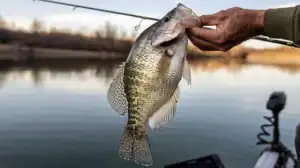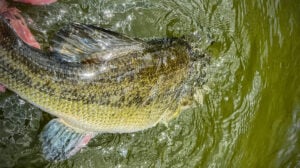Does crankbait color really matter in mud? Well, of course it does. I’m with you, what a preposterous thing to even propose. I mean, the core tenants of all bass fishing lure production are founded on bass being able to see certain colors better in certain situations. Bright or two-tone contrasting color patterns are must haves in muddy water… right?
This was certainly the thought process to which I had become conditioned and even personally perpetuated on the masses through every article I’ve ever written and video I’ve ever shot on the subject in nearly two decades of doing this.
A chartreuse and black-back squarebill has always been my go to in muddy water. A bait I pick up with utmost confidence in those situations, knowing that if I have to get a bite, this is the bait for the job.
So it was a bit of a jaw-dropper when one of my good buddies, who I trust as much as any other when it comes to life and bass fishing, told me that he had a good buddy who caught fish on a clear crankbait in muddy water.
Why? That was my first question.
He had done it just for the heck of it, to see if he could get bit and he proceeded to catch fish. What a preposterous thing to even consider doing and had I heard it from almost any other fisherman, I would have rolled my eyes and moved on.
But there was a nagging curiosity concerning this story from Tom Frink about his buddy Andy Wicker that just wouldn’t go away. So I ordered a “nude” squarebill crankbait and decided to test this ridiculous idea out myself. Can a bass really locate and eat a clear, silent crankbait in muddy water? What I found shocked me more than anything in fishing has, throughout the course of my whole life.

On-the-water results
I first took to Yates Lake on February 8, 2023 to give the clear crankbait a try. I had my dad with me and he was tasked with throwing our old faithful chartreuse and black-back squarebill from the back of the boat while I flung the clear crank from the front to at least give it the first shot at things. It only took 16 minutes in the sub 60-degree water for me to get a bite. I was as surprised as any one of you are right now; I guarantee that.
The water wasn’t chocolate-milk muddy but there was less than a foot of visibility for sure and that would have been gauging it with a big, bright spinnerbait. The clear squarebill disappeared into the abyss just a few inches in. For the next 5 hours, I picked this crankbait up off and on and caught two more small bass on it in the muddy water, all the while my dad rotated between the chartreuse and black-back squarebill and a big spinnerbait and had only one bite.
I had already seen all I needed to see to firmly believe that this clear crank would get bit in mud but my ego wouldn’t allow me to post this piece without at least a two-pounder to go with it. The next time I had a chance to throw the nude Strike King 1.5 in muddy water came on Lake Eufaula on February 22. I spent approximately two hours throwing this bait on riprap in water with less than a foot of visibility and caught 5 or 6 more fish.

What does this mean?
So I caught fish on a clear crankbait in muddy water… but what does this really mean? Should I throw away every bright-colored bait I have because color simply does not matter to a bass?
Well no; I don’t think that’s the takeaway from all of this. Although I do believe now that color likely matters more in clearer water than it does in muddy water, which is a big shift in my way of thinking.
It’s been theorized for years that bass rely on their lateral lines in large part to hunt. The lateral line of a bass is a system of sensory organs that are able to detect movement, vibration and pressure changes in the environment around the fish. So this is how the bass were able to target and eat my clear crankbait, even in water where they couldn’t have possibly seen it.
Probably the most astonishing part of this whole process was that the clear crankbait I used didn’t even have a rattle in it to attract the bass. It was a KVD 1.5 silent squarebill. So the bass had no color or sound to work with, simply the water displacement of the wobbling bait and any minuscule sound the lure might have made colliding with the cover. What a mind-bending experience for me as an angler.

Conclusion
Color certainly still matters. But it becomes more important as the water clarity improves, especially with moving baits. It still likely helps to use dark, slow-moving baits like jigs and Texas-rigged worms in muddy water, so the bass may be able to see the silhouette of the bait as it crawls by.
But for baits that are on the move in the mud, like squarebills, spinnerbaits and even lipless cranks, the amount of vibration they put off matters far more than the color, in my opinion. And that opinion is different now than what it used to be, on account of the real-world proof I cannot deny. If you have your doubts, give it a try… but be ready to have your world rocked.
















